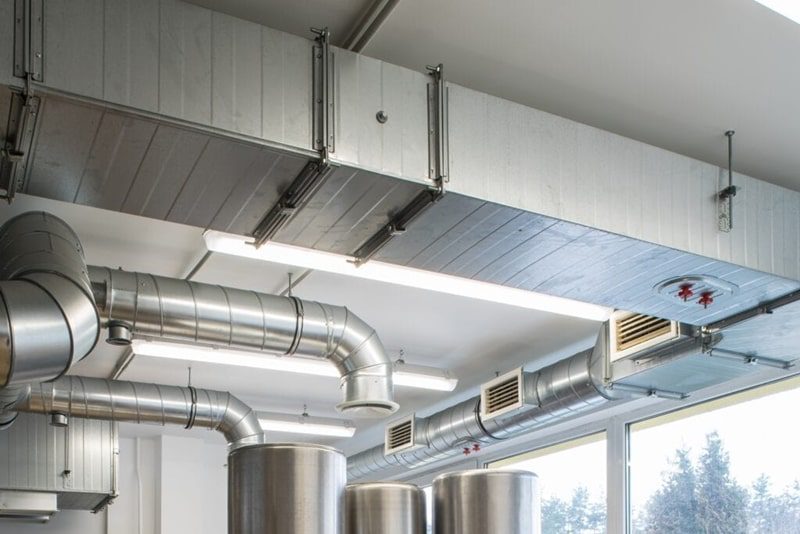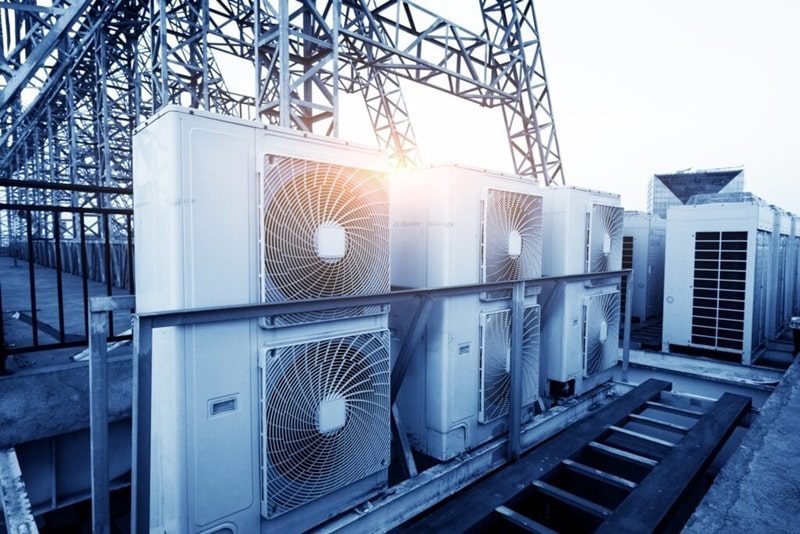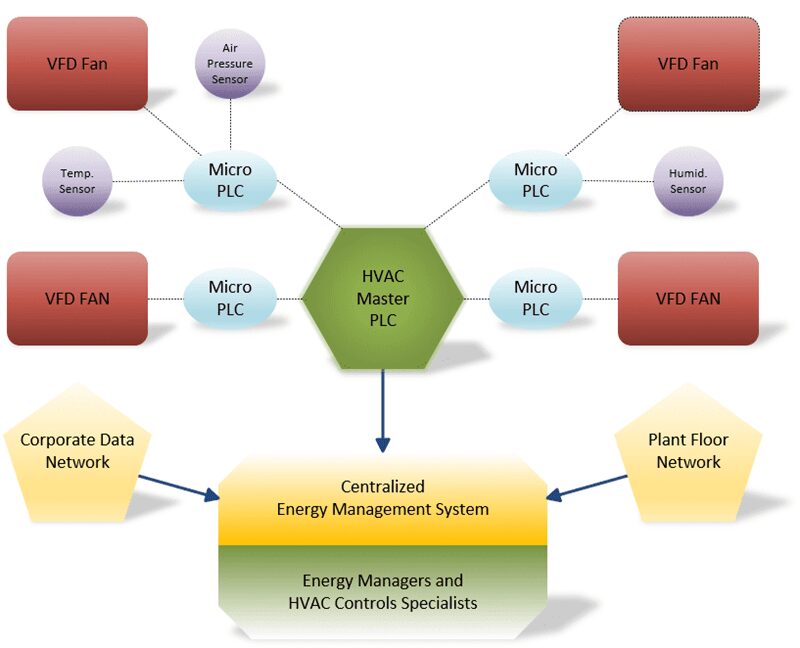Many manufacturers across the U.S. are aware of the advantages advanced HVAC systems control can offer in their manufacturing facilities. Since many manufacturing processes involve ventilation, heating, cooling, or air moisture control, either directly or indirectly, HVAC control is essential to managing costs and manufacturing processes.
Precision, reliability, and strong metrics are all key to HVAC control in the manufacturing setting. The ability to monitor and verify HVAC energy usage and other feedback data, control and program operation schedules to align with production, and evaluate under-performing or malfunctioning equipment are all made possible through HVAC controllers. These data and functions, in turn, are part of overall strategies in energy management, operational efficiency, system maintenance, and more.
Legacy HVAC Controls
Most HVAC systems in manufacturing facilities today are controlled through a proprietary system supplied by a major HVAC equipment company. The controls are designed to operate within particular bounds designated by their manufacturers and require outside technicians in order to service, re-program, or otherwise customize these systems.
This inconvenience keeps the manufacturing firm dependent on the HVAC equipment company as the controls are generally pre-loaded hardware for a set of particular functions and cannot be modified to interact with existing plant operation systems or centralized building management systems. Many times, these systems are either not connected through a network or are on a network that is very different and not compatible with the manufacturing floor network.
HVAC controls structures such as these are limiting for building and energy managers seeking maximal energy savings, platform integration, and customization to their specific needs. Linking HVAC controls to a wider platform designed to monitor and manage energy usage can yield insights into energy waste, open the door for greater efficiency, lower utility and maintenance costs, and help solve operational issues before they arise and affect productivity.
Energy Management Systems AND HVAC
Energy Management Systems (EMS) give industrial and manufacturing plant operators control over the energy usage of their facility and allow them to monitor and respond to alarms generated by the systems. Each component of a manufacturing facility that requires energy is subdivided in an EMS and can be controlled and monitored independently. Energy managers can see how much power is drawn by production, lighting, conveyance, air compression, and so on.
Top EMS platforms allow for in-depth energy usage analytics enabling measurement and verification (M&V), peak load prevention and load-shedding strategies, and the formation of energy KPIs (key performance indicators). These advanced energy management strategies can often be part and parcel of energy rebates and incentives provided by local utilities. Being able to measure and prove energy savings is often required for certain energy savings programs which can ultimately save manufacturers hundreds of thousands annually on utility bills. Monitoring at the subsystem level also allows for the detection of faulty or failing machinery, which can be a cause of additional energy waste.
Imagine a scenario where a manufacturer adds variable frequency drives (VFDs) to a handful of fan motors on a plant floor and each VFD has ethernet capability that offers magnitudes more data than anything a plant operator could have previously imagined. By integrating HVAC into an EMS and adding sensors in the right places, a manufacturing facility could potentially save tens or hundreds of thousands of dollars per year on energy costs. The greater level of customization, granular detail, and system integration in your HVAC/EMS, the more money you stand to save through utility costs and operational efficiency.
Today’s standard HVAC controls usually lack full EMS integration or require technical support to manage and modify the system. Plant operators have personnel on staff that are fully capable of developing, enhancing, and operating ruggedized and programmable computers called Programmable Logic Controllers (PLCs) on the manufacturing floor. Despite that fact, most plants still utilize HVAC systems that use unitary controllers or direct digital control systems developed for commercial buildings that are not programmable in this way. The new paradigm of HVAC control takes advantage of the PLC knowledge and technical skills on hand in any manufacturing plant and allows them to be applied to HVAC controls, resulting in cost savings, increased control, and extraordinary agility in addressing production issues.
The Rise of Programmable Logic Controllers
The next generation of energy management and HVAC control for manufacturing facilities is arriving now in the form of PLCs. Today’s modern manufacturing facilities are made up of a network of PLCs, each controlling a part of an automated production line or system. If there is an issue or discrepancy with a particular aspect of a manufacturing process—say conveying product from one process to another—an engineer can look at the PLC, analyze the data at the particular site of the issue, and make a modification to solve it, all on the fly and without any outside support.
This ability to rapidly troubleshoot and optimize an automated system was first designed for automobile manufacturing, but its usefulness has seen it spread across virtually every automated manufacturing sector. The latest PLC innovation—micro-PLCs—has seen the physical apparatus become smaller, cheaper, and more universal, allowing engineers to master PLC maintenance and customization all across the factory floor and bring historically disparate systems into the fold for even greater efficiency gains.
In the HVAC control context, the newest micro-PLCs are designed not only to be programmed with open source code but can easily integrate with other network nodes that can be unified and centralized within an EMS. These features enable an unprecedented level of accurate and rapid HVAC system optimization, all without having to coordinate with outside vendors. A new level of HVAC control, visualization, and efficiency can be achieved by manufacturers of any type by utilizing centralized primary PLCs and a network of micro-PLCs at each HVAC unit and then synergizing advanced data analysis available through the latest energy management systems with the interconnectivity and customization of the micro-PLCs.
In addition to their familiarity with plant floor staff, micro-PLC HVAC control systems offer a superior level of customization. These PLCs utilize open-source ladder logic for programming and allow for rapid application development software for visualization. A manufacturing facility’s controls team can now design the system’s logic in whichever way makes the most sense for that operation, and quickly assemble visual interfaces tailored to their needs.
Furthermore, micro-PLC units can operate with existing Historians and SQL databases for data storage, meaning other elements of your energy management system can easily query an individual PLC for analysis and monitoring. The level of customization of PLCs has helped lead the way in terms of maximizing efficiency on manufacturing floors, and now that same advantage is available in HVAC systems.
There are hundreds of extremely specific HVAC-related manufacturing processes that take place in all types of manufacturing plants. In the past, the level of fine-tuning for energy efficiency was based solely on what an HVAC equipment manufacturer happened to offer in their control systems. Today, with micro-PLC technology, minute and specific process control for maximizing energy efficiency is only limited by an engineer’s imagination. Each particular device and HVAC-related process can have its own custom schedule, procedure, alarm limits, and so on.
Example of Micro-PLC/EMS Integration
Veregy recently helped a 400,000 square foot food manufacturing facility in the Midwest integrate micro-PLC technology with the facility’s existing EMS. The site had 54 packaged rooftop units, 12 make up air units, 14 exhaust fans, and two air handler units (AHUs) with cooling and heating sections. Each of these units was retrofitted with new control panels comprised of a new micro-PLC, a new wireless ethernet radio, and an unmanaged network switch.
The local supply air, return air, and outside air temperature sensors were tied into the new micro-PLC, as well as other local inputs and outputs such as gas valves, chilled water valves, compressor controls, and damper controls. Plant temperature, pressure, and humidity sensors were also installed inside packaging, processing, warehouse, and office areas.
As part of this project, a new master PLC with a touchscreen monitor utilizing the plants’ existing HMI software was installed to monitor a new HVAC local network and to communicate directly with the micro-PLCs installed at each unit. These micro-PLCs control both the HVAC unit as well as the corresponding VFD. The master PLC then establishes a global strategy to maintain proper temperatures, pressures, and humidity in each of the respective areas by monitoring the sensors that were installed.
This new EMS network was tied into the manufacturing plant floor network utilizing ethernet modules in the master PLC. It was also tied to the corporate network through a managed switch so that historical data could be stored on a corporate SQL server. The plant now has local visualization and control of all HVAC equipment and can have unlimited data stored on the corporate database.
Additional visualization can be created to allow for situational awareness that gives the operators and plant management greater insight into the HVAC operations and energy performance. Key performance indicators showing kilowatt-hours and therms consumed by the HVAC system can be shown in real-time. Additionally, the efficiency of the system in kilowatts per ton can be trended and is monitored to ensure optimal efficiency is always maintained.
This new PLC-based system allows the control specialists at the plant to access all of the micro-PLCs as well as all of the new VFDs through the platform network on their computers. They are able to get into the PLC programs, troubleshoot, and modify the strategies in real-time from the comfort of their office. It also allows plant management to view the performance of the system and to report ongoing energy savings as well as area temperatures, pressures, and humidity, which can help ensure a space meets the company’s specifications required for optimal product quality.
This project saved over $250,000 in electric and gas costs and resulted in a simple payback of fewer than three years.
PLC-Based Energy Management Systems are the Future
The power to put all EMS and HVAC system controls on the manufacturing floor network under one umbrella has arrived. Instead of separate systems for plant operation management, energy management, and HVAC management, tomorrow’s manufacturing facilities will have a unified control system comprised of a network of micro-PLCs and a central PLC under which each of these once separate systems becomes an interconnected subsystem.
With the addition of data flow from individual HVAC units to a centralized database and the accrual of historical system knowledge, substantial system optimization through big data can be achieved. Combining today’s advanced EMS analytic capabilities with on-the-ground subsystem energy monitoring in the form of HVAC micro-PLCs results in a synergistic effect on energy savings, efficiency, and system control.
When every kilowatt-hour and every ventilation and cooling fan can be monitored, controlled, debugged, and managed through a micro-PLC, a manufacturing facility’s ability to cut energy costs is at its pinnacle.
***
Eric Spink will be presenting on the topic of PLC-Based Energy Management Systems at the AEE World 2019 Energy Conference & Expo taking place September 25-27th in Washington DC. Read more about Eric and the conference on the AEE conference website.




